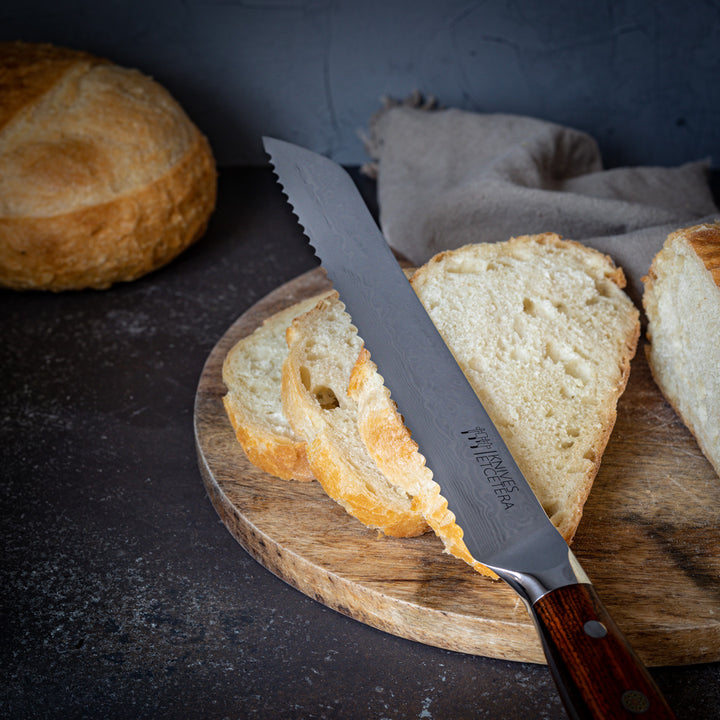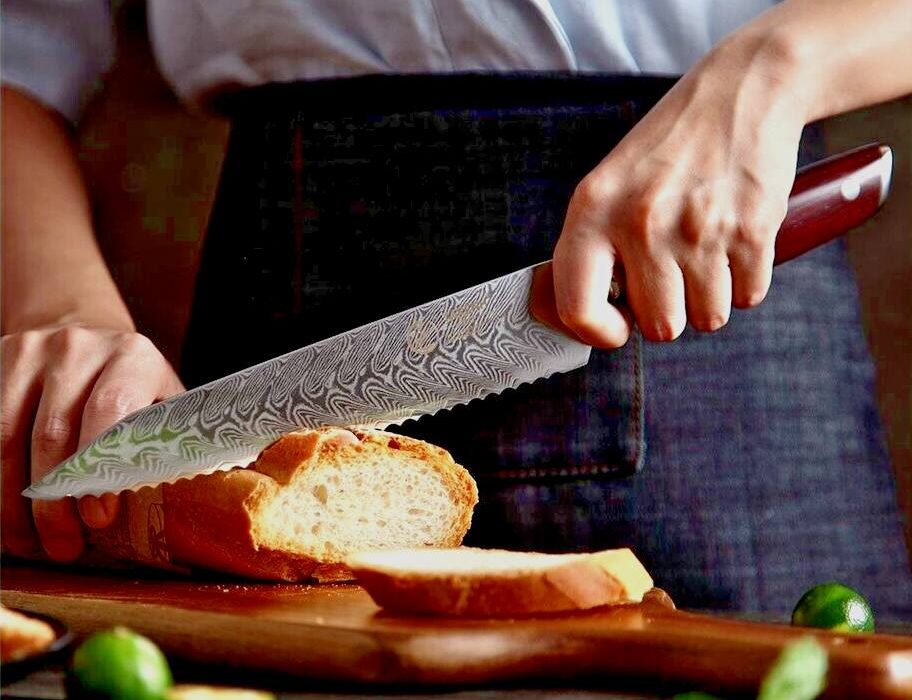Cutting bread may seem simple, but like many kitchen skills, it requires proper technique to achieve the best results. Using a serrated knife is the recommended method for slicing bread, as it makes the process easier and the slices even. In this article, I will share the proper technique for cutting bread with a serrated knife, ensuring you can add a professional touch to your kitchen skills.

Understanding the Serrated Knife
Before diving into the technique, it’s essential to understand the tool you’re using. A serrated knife has a jagged edge, which is ideal for cutting through foods with a hard exterior and soft interior, like bread. The saw-like teeth of the serrated knife grip the crust of the bread and slice through it without crushing the interior.
Anatomy of a Serrated Knife
A standard serrated knife consists of a handle, a jagged blade, and pointed teeth. The blade length varies, but most bread knives are between 8 to 10 inches long. These features make the serrated knife perfect for cutting through crusty, chewy foods.

Why Use a Serrated Knife for Cutting Bread?
Serrated knives are the best choice for cutting bread because of their design. The knife’s teeth catch and cut through more resilient crusts without squishing the bread inside. This brings us to the first important point: always use a serrated knife when cutting bread for an even, clean cut.
Benefits of Using a Serrated Knife
- Even Cuts: Serrated knives provide uniform slices without crushing the bread.
- Less Effort: The serrated edge grips the surface, requiring less force.
- Versatility: They’re useful for cutting other foods like tomatoes, cakes, and roasts.

Proper Bread-Cutting Technique
Now that we understand the tools, let’s delve into the proper technique for cutting bread with a serrated knife.
1. Choose the Right Knife
Ensure you select a suitable serrated knife. A bread knife with a blade length of 8 to 10 inches is usually sufficient.
2. Use a Steady Surface
Place your bread on a stable, flat surface. A cutting board is ideal to prevent slipping.
3. Hold the Knife Correctly
Grip the handle firmly but comfortably. Ensure your fingers are wrapped around the handle for control.
4. Gentle Sawing Motion
Use a gentle sawing motion back and forth, allowing the knife’s teeth to cut through the crust and the softer center. Avoid pressing down hard, as this can squish the bread.
5. Start Slow
Begin your cuts slowly to establish a groove. Once the knife starts to cut through the crust, you can increase the speed slightly but maintain steady movements.
6. Maintain Even Pressure
Keep the pressure even as you cut to ensure the slices remain consistent in thickness.

Additional Tips for Perfect Bread Slices
Tip 1: Use Fresh Bread
Fresh bread is easier to cut. If your bread is a few days old and slightly hard, warm it slightly to soften the crust.
Tip 2: Experiment with Angles
While a straight-down motion works well, experimenting with cutting angles can give you different results that might suit your needs better.
Tip 3: Store Your Knife Properly
Keep your serrated knife in a protective sheath or knife block. This keeps the blade sharp and ready for use when needed.
Tip 4: Regular Sharpening
While serrated knives do not need frequent sharpening, they require maintenance to keep the teeth sharp. A professional knife sharpener can handle this task.
Common Mistakes and How to Avoid Them
Avoid these common mistakes to master the proper bread-cutting technique.
Mistake 1: Using the Wrong Knife
A straight-edged knife will squish bread and is not effective for cutting through crusts. Always use a serrated knife.
Mistake 2: Using Too Much Force
Excessive force crushes the bread. Use even, gentle pressure to slice through the loaf.
Mistake 3: Not Maintaining the Knife
Keep your knife sharp and in good condition to ensure optimal cutting performance.
The Ideal Bread Knife Care
Cleaning Your Knife
Hand-wash your serrated knife with warm, soapy water. Avoid dishwashing, as it can dull the blade and damage the handle.
Storage Tips
Store your serrated knife in a knife block or protective sheath. This prevents damage and maintains the blade’s sharpness.
Frequently Asked Questions
What is the best way to clean a serrated knife?
Hand-wash with warm, soapy water and dry immediately to prevent rusting.
How often should I sharpen my serrated knife?
Sharpen it every six months to a year, depending on usage. A professional knife sharpener can help.
Can I use a serrated knife for other foods?
Yes! Serrated knives are versatile and can cut foods like tomatoes, cakes, and roasts.
For more information on knife sharpening techniques, visit [how to sharpen a chef knife](https://knivesgenius.com/how-to-sharpen-a-chef-knife/)(rel=’dofollow’)
As an Amazon Associate, I earn from qualifying purchases.


